With the snow and ice at the beginning of the year, closely followed by lockdown, “Old Nick” has spent most of its short life on a mooring, hooked up to the shore power, unable to go anywhere.
Never having had solar panels before, I was under the naive assumption that they would just do their thing and supply the power we used during the day. I obviously understood that in the winter months their output would be a small percentage of what they produced in the summer (approximately 10%) but I had over looked one important fact.
Solar panels or to be more precise the MPPT controller will only supply power if that power is required. This is a key piece of information to remember and when you think about it, makes perfect sense. The MPPT’s job is to provide the most optimised power matching between the panels and the batteries. If the batteries are fully charged, then the MPPT backs off its output power and you see the panel voltage increase and the panel current reduce.
The screen shots below show the MPPT power output during a normal winter day, with the shore power connected and the Victron Quattro in normal combined charger and inverter mode.
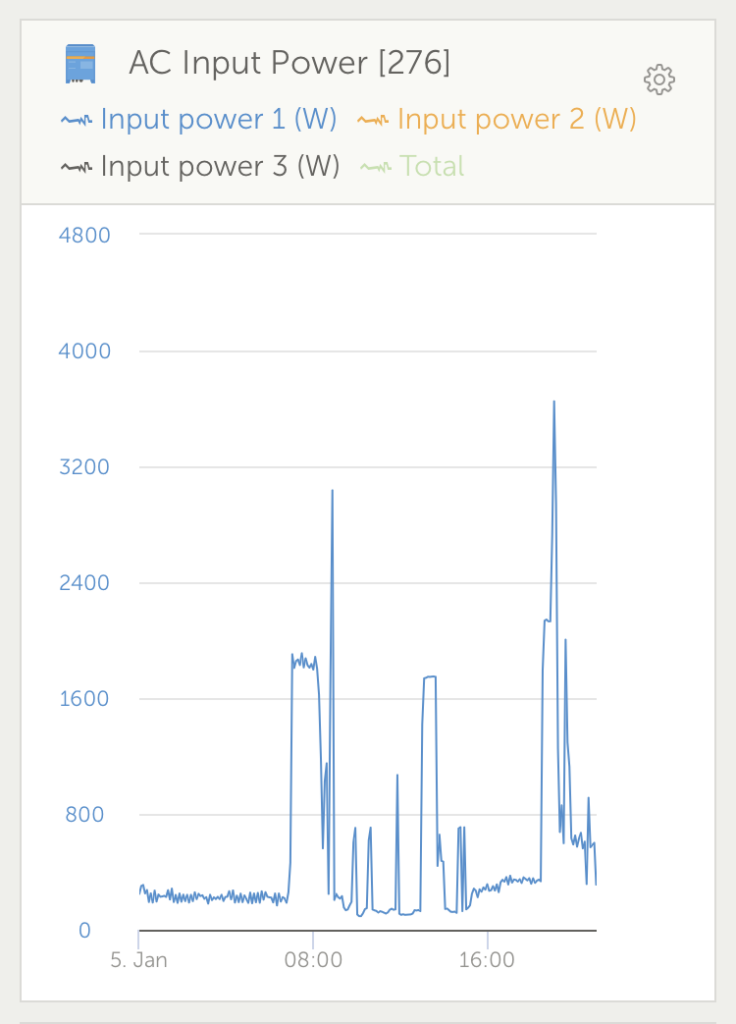
AC Shore Power 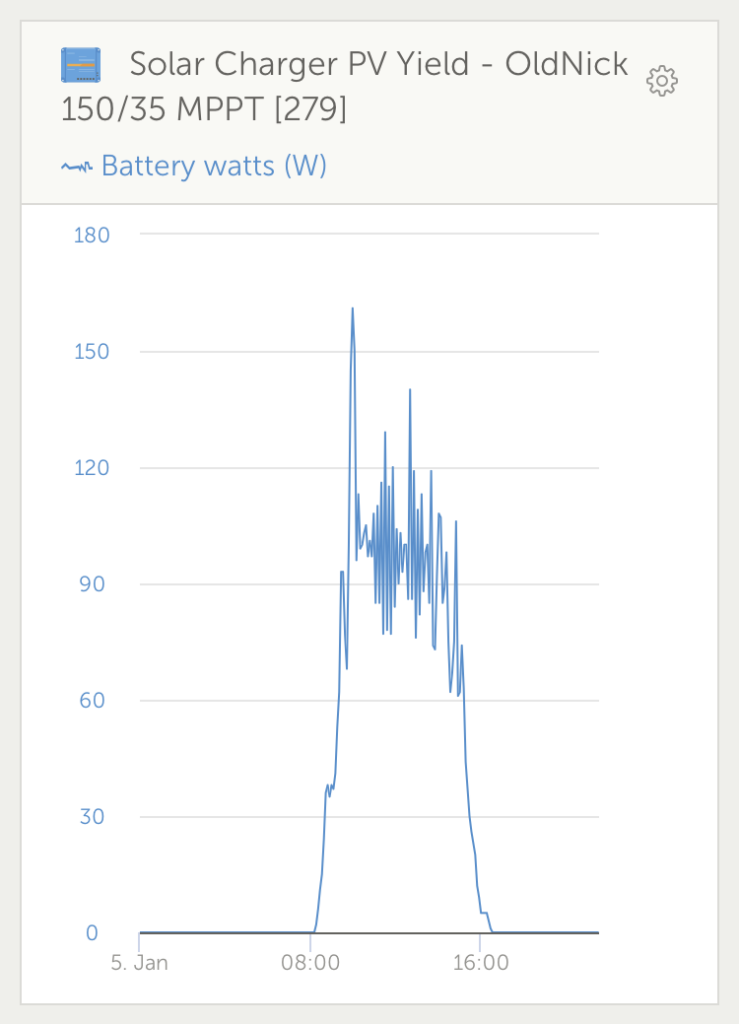
MPPT Output Power 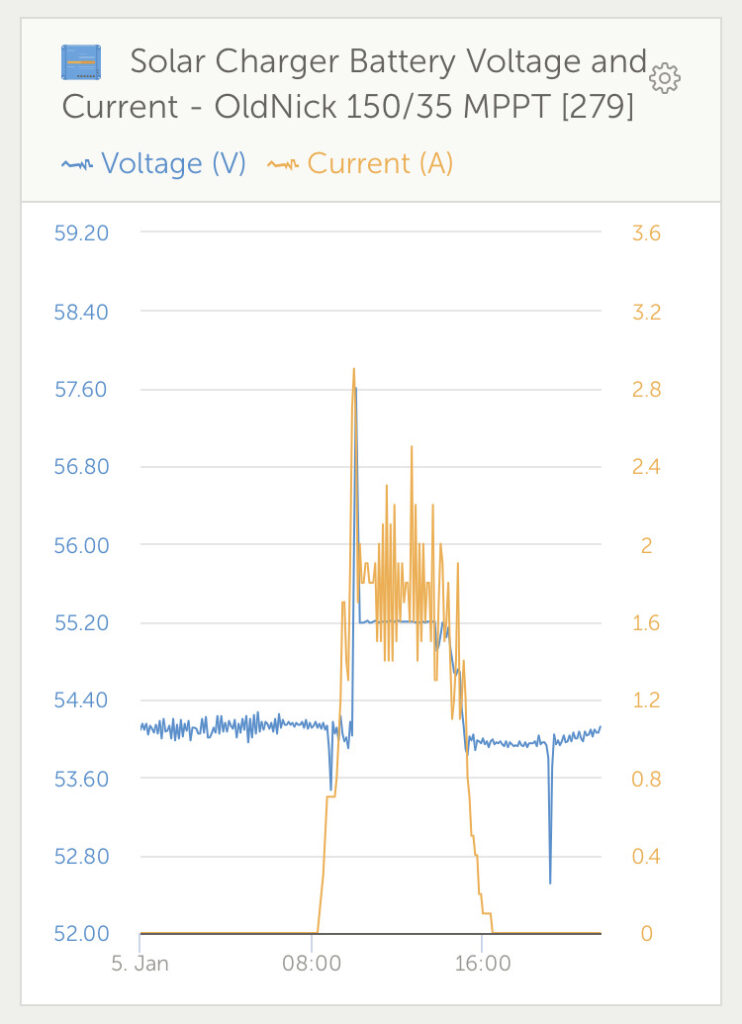
MPPT Voltage + Current
As you can see the AC power taken from the shore supply fluctuated throughout the day as we boiled kettles, the water heater came on, etc. all pretty normal for a day onboard. The MPPT did provide some solar power in to the system, but because the batteries were fully charged the demand for power was low, so the current output from the MPPT averaged around 1.7A and the power taken from the solar panels averaged around 100W.
Once the penny dropped, and I appreciated that to get maximum solar power out of the MPPT, I would need to turn the charger off, I was a “man on a mission”. Every day I would switch the Victron Quattro to “Inverter Only” mode and then at the end of the day switch it back to normal Charger + Inverter mode. The results were amazing, with at least a x3 increase in solar yield.
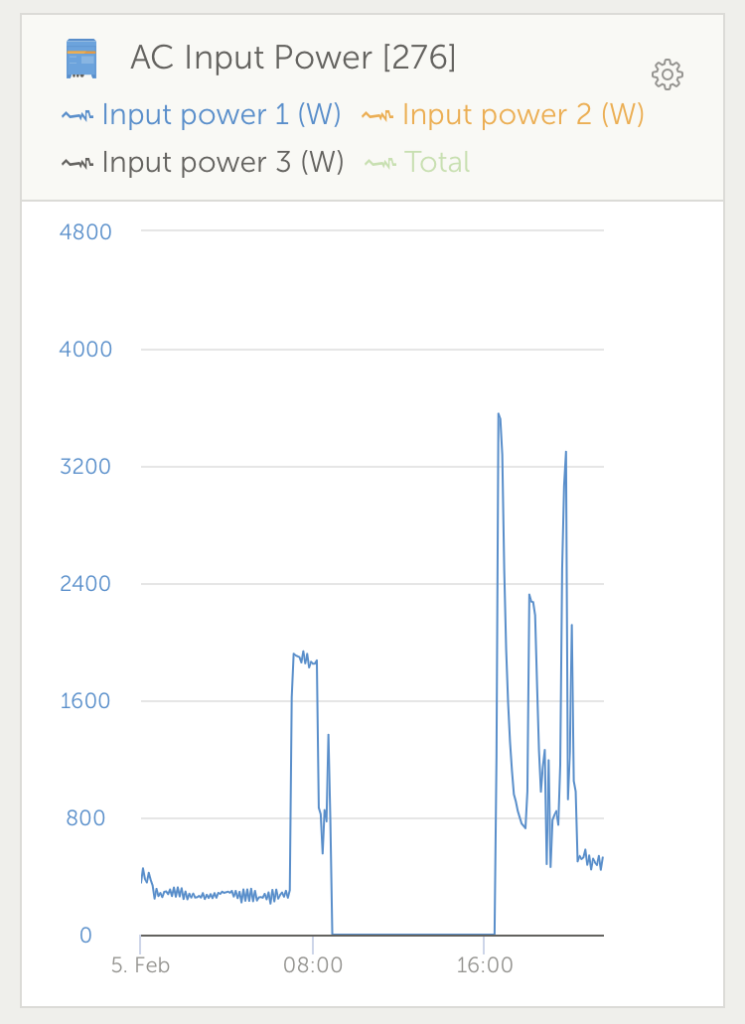
AC Shore Power 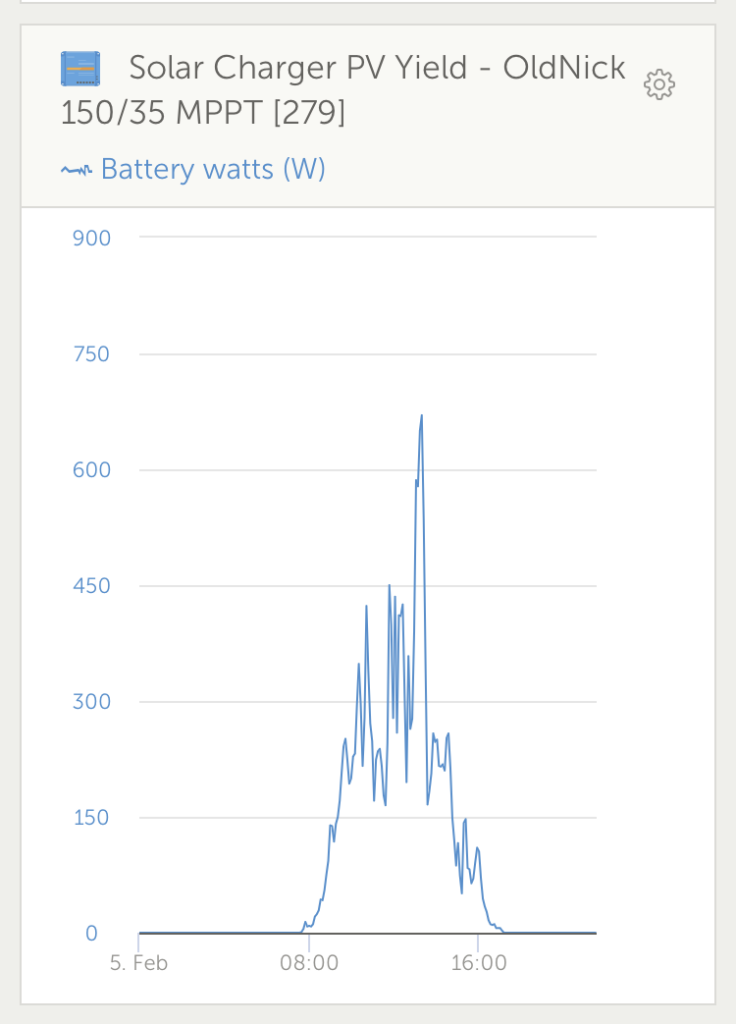
MPPT Output Power 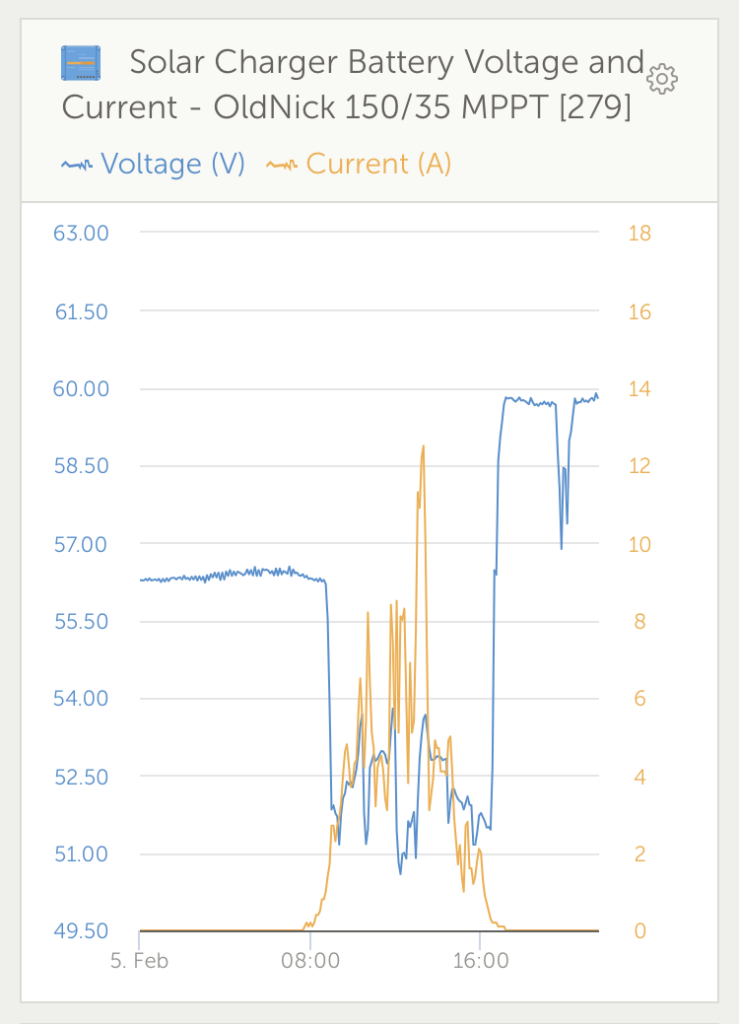
MPPT Voltage + Current
As you can see, the AC Shore Power goes to zero as soon as the Inverter Only mode is selected and once the batteries start to discharge, the MPPT starts to increase its output power as it is now the sole battery charger. Now we are seeing an average output current from the MPPT of around 6A and average power of 300W, which over the course of the day resulted in a solar yield of between 1.5KWh and 2KWh which is pretty good for February.
After a quick chat with Rob at Ortomarine, it became clear that with a bit of extra code in his PLC and the “Ortomate” colour controller, we could have a new “Solar Eco Mode” for the Quattro that automatically switched the “Inverter Only” mode ON and OFF based on the state of the solar panels and the batteries.
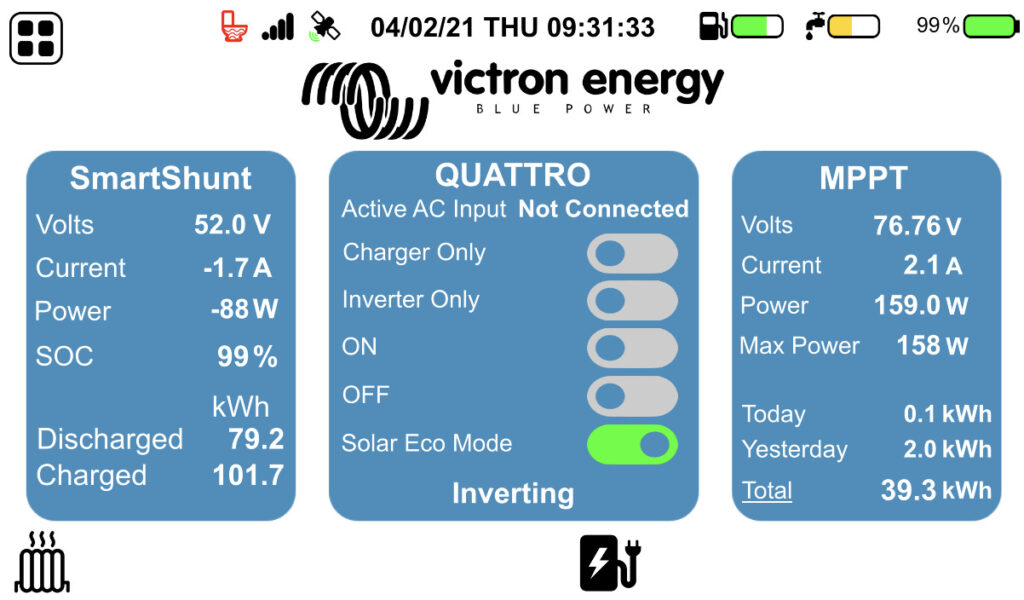
With the idea planted, Rob managed to get the code written, tested and downloaded to “Old Nick”, despite his busy schedule, in just a couple of days and now I have a nice new “Solar Eco Mode” that I can select whenever we are on shore power. As well as being better for the environment, it should reduce the amount of electricity “top-up” cards that we have to purchase from the marina – win win!


I can’t resist saying “you’ve got the power” and cueing up some dodgy dancing.
Goodness it’s fantastic what can be achieved with some careful code.
May your kettle boil promptly
xxx
We’ve already done that one!
Hi Emma,
Yes, the code, in general, is careful…but if you push me, i will also write dangerous and wreckless code – but i really don’t think Paul and Kay are quite ready for that yet!! 😉
Rob (Ortomarine) – Sensible code writer!
Hi Paul, enjoyed reading this post. Since having my solar system installed last year, I’ve been manually managing the solar input by switching off the shore power usually overnight. I was told that I should not be scared to cycle the Leoch batteries as they are very hardy and tolerate cycling well. This has served me well until recently, as now we have sometimes got an electric oil filled radiator on overnight. That’s 1kW on/off overnight, resulting in waking one morning to the battery at 42% SOC!
I’m hoping to get my Victron MPPT to do what you do with your Eco Solar mode. But I also want it to reconnect shore power say when SOC gets down to 60% automatically. Need to do some serious reading up on this!
Hi Steve, I think you need to do the opposite and turn the shore power off during the day. This will optimise your solar yield and safeguard against the heater draining the batteries. 42% SOC is OK for lead carbons but you would not want to go any lower on a regular basis.
Hi Paul, yes I am 100% Solar during the Spring/Summer but I’m getting such little charge from 650W solar in winter that it won’t support resistive loads for long during the day with no shore power support. Bearing in mind that 880W on/off during the day is taking a huge draw compared to the solar input. Let’s say 4 hours use, that’s >290ah and my battery is 462ah. Don’t forget that the bigger your battery capacity the longer it takes to recharge your losses so I don’t like going less than 60% SOC. For me putting back 40% charge requires nearly 6 hours from my alternator which is my most powerful charge device. Hence, I base all my discharge/charge rates on not using shore power to know I can cope while cruising.
One thing you might want to do if you haven’t got it yet, and this can be utilised with Victron MPPT, during summer months particularly. Enable the MPPT to divert excess solar charge to heat the immersion coil until SOC gets to a defined limit the switch to charge and vice versa. Haven’t yet achieved it. I know it’s possible, but I would need a 12/230V relay between the MPPT and the immersion which I haven’t sourced yet. Might not be needed for your big battery, but I found during the summer that I had power absolutely wasted and nowhere to go, even with washing machine on, kettle etc.
Hi Steve,
Rob here (Ortomarine). Some good points raised and it’s nice to hear you take your battery charge/discharge regime seriously…bodes well for long battery life! Regarding solar dumping, as this is an all electric-propulsion boat, the majority of battery discharge will be down to daily cruising, followed by cooking in the evening. We already use an SSR to control the 1.5kW immersion element, so using the PLC’s transistor outputs, we can easily utilise a PWM function to modulate heater power vs solar/SOC% levels (or any other variable we choose) for days of extended mooring. It’s very useful to be able to read all the Victron data within our PLC. This allows several conditions to be programmed that vary with environmental and cruising requirements, creating a power profile that fits external conditions.
Regards,
Rob
For those that wondered…
SSR = Solid State Relay
PLC = Programmable Logic Controller
PWM = Pulse Width Modulation
Hi guys. I like this new Solar Eco mode, sounds excellent for the type of cruising we plan to do with a 3 to 4 month layover in a marina for the worst of the winter. I know our new boat is still a couple of years off yet Rob, but will you be putting this option into all your new builds in future?
Hi Matt, sorry just was your comment and approved it. I am sure Rob will chime in, but I believe everything we have done on Old Nick will become standard features on future builds.
Hi Matt,
Good to hear from you and nice to see you keeping in touch with updates on our boats! I’m not really known for my chiming, but i’ll give it a go! So, with all the developments we’ve made over the last 18 months or so, in terms of monitoring and control on our boats and the data we’ve been able to gather from existing installations, it has allowed us to create a fairly flexible system, in terms of additional features and modifying existing functions. So yes, options such as ‘Solar Eco-Mode’ will be fairly standard within the software. With each customer requirements being slightly different (in terms of leisure or continuous cruising etc), we can tweak some of the options to best suit their particular use of the boat.
Do stay tuned though, as there will be several other additions and enhancements over the coming months, no doubt!
Regards to you and Pauline!
Hi Rob
Grateful for your comments. I do hope you and Paul and Kay don’t see my comments as challenging anyone. I’m purely a nerd wanting to understand more! I’m presuming your use of the PWM is in place of an electro mechanical relay? Which sounds like much more sense. I’ve emailed you (Rob) separately for a business request.
Thanks
Steve